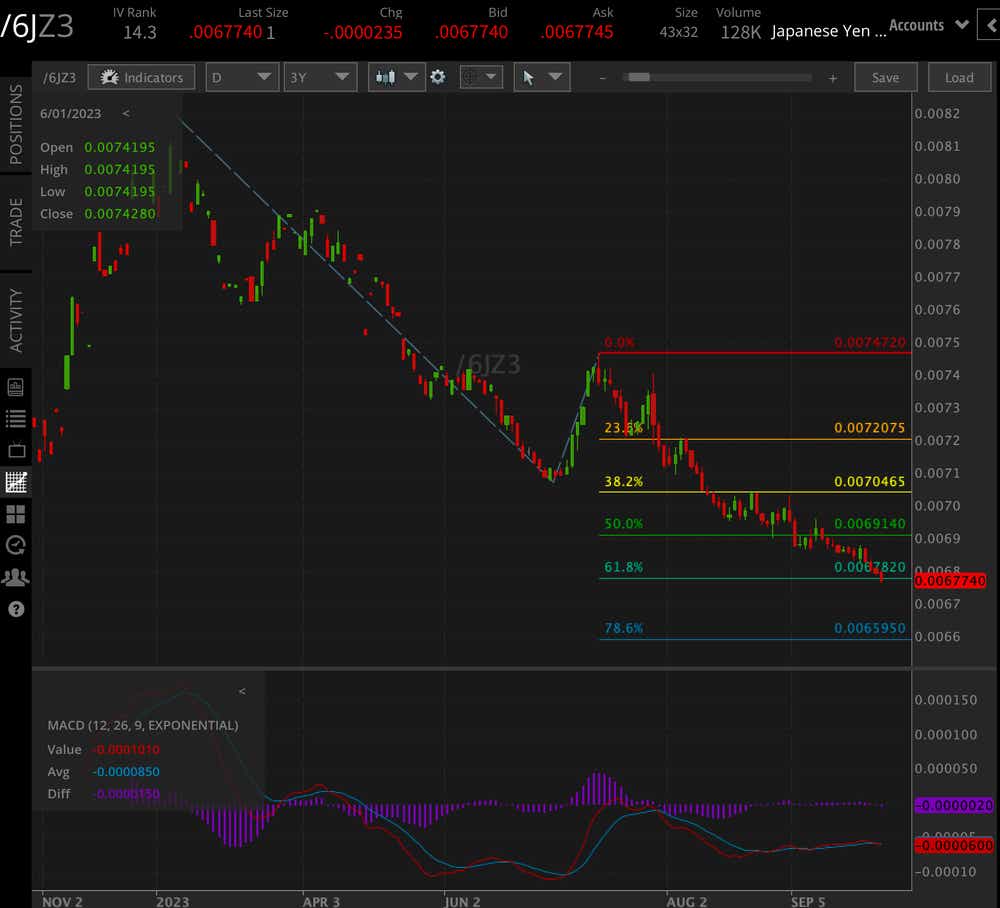Japanese Yen Enters Intervention Zone

Japanese Yen Enters Intervention Zone
Yen traders are on intervention watch. Will Japan Defend JPY?
- The Japanese yen is past intervention levels.
- BoJ July minutes shed light on policy stance.
- Technical outlook for /6JZ3 biased lower.
The Japanese yen (/6JZ3) is down again, about -0.35%, on Wednesday, keeping pace with a string of losses that have slowly but consistently dragged the currency lower. Since January, the yen has lost nearly 20% of its value against the dollar.
This move puts the yen around the 150 level against the dollar, which was last traded at back in October 2022, when the Japanese government intervened in the market to stem further losses. The move is now occurring under different circumstances. For one thing, the velocity of the yen’s decline has been consistent and slow.
Meanwhile, the yield differential between Treasury bonds and Japanese Government Bonds (JGB) has widened considerably. The premium found in the U.S. 10-year is at nearly 390 basis points and widening. Such a gap is hard to ignore and suggests that further yen weakness is to come.
In that case, the U.S. central bank could shift to a dovish posture, which is not the case currently and is unlikely within the next few months. Or, the BoJ will have to back off its current stance, which is more likely and what we will talk about next.
The Bank of Japan to dictate yen's direction
A recent policy decision from the Bank of Japan (BoJ) didn’t do anything to stem yen selling. Overnight, the policy minutes from its July meeting crossed the wires, shedding light on policymakers’ decision process.
BoJ members were largely at a consensus when it came to the bank’s current stance of maintaining ultra-loose monetary conditions. However, there was some disagreement about when negative interest rates would end and if wages would continue to rise.
According to the minutes, members believe that a definitive point could be reached in early 2024 that would allow enough clarity on wage gains and inflation targets to allow the end of its current policy stance. While that is still a while away for traders, it could limit the depth of yen declines beyond a short period. For now, traders will have to assess more timely data and trade accordingly.
Japanese yen technical outlook
Currently, /6JZ3 is breaking through the 61.8% Fibonacci extension from the January to June (A-B) move. Next stop for bears would be the 78.6% Fib extension seen on the chart below. For now, the technical posture is well positioned for a bearish continuance.

Thomas Westwater, a tastylive financial writer and analyst, has eight years of markets and trading experience. @fxwestwater
For live daily programming, market news and commentary, visit tastylive or the YouTube channels tastylive (for options traders), and tastyliveTrending for stocks, futures, forex & macro.
Trade with a better broker, open a tastytrade account today. tastylive, Inc. and tastytrade, Inc. are separate but affiliated companies.
Options involve risk and are not suitable for all investors. Please read Characteristics and Risks of Standardized Options before deciding to invest in options.